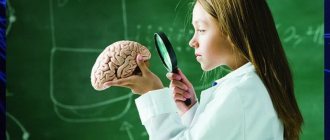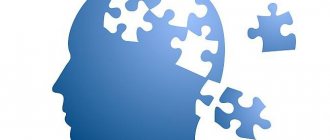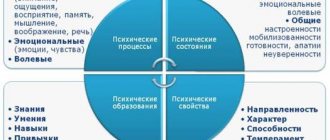Concept and essence
Primitive man sought to understand and transform the world around him.
At first he came into contact with nature, animals, and inanimate objects. As I developed, I learned to create, change objects, and transform nature. Activities are a controversial, little-studied topic. They began to pay active attention to it in the middle of the 20th century. A. Leontyev defined it as the process of satisfying the needs of the subject. For Soviet psychologists, it was not the activity itself that was important, but the mental processes based on it.
The term “activity” should be distinguished from the synonyms “movement” and “activity”. These terms describe the movement of matter. To describe the properties of inanimate matter, the term “motion” must be used.
The appearance of living matter caused the emergence of a new form of movement - activity. The actions that animals perform to maintain existence should be called life activities. The activity of an individual with awareness can be called full-fledged activity.
Some psychologists believe that highly organized animals also have the ability to engage in conscious activity. Primates, in addition to the actions necessary for survival, have the ability to play.
Kinds
The most primitive example of a type of mental activity is stereotypical activity, which works at the level of reflexes. These are habitual actions that are repeated with constant frequency, working as a reaction to certain stimuli - these can be any habits or simple work skills.
The most complex type of such activity can be called creativity, since it is distinguished by originality and uniqueness, and, in addition, carries with it a socio-historical meaning. As a result of such activity, a fundamentally new product is created - an invention, a work of art, etc.
Basically, mental activity is divided into the following types:
- sensation;
- perception;
- performance;
- thinking.
Conscious
A conscious program of behavior is the dominant behavioral system for a socially adapted individual. Although other areas of mental activity always play a background role in a person’s behavior, being a kind of basis, nevertheless, the main active program in a person’s life is conscious actions.
Human consciousness is a mechanism for the conceptual regulation of his behavior and activities. Human activity differs from the behavior of animals in creative productivity and structural differentiation, which is essentially an awareness of the goals and motives of one’s actions, as well as the use of means and methods created during cultural and historical development, as well as the use of knowledge and skills acquired in the process of socialization and adaptation.
Thus, a person’s mental self-organization, as well as his adaptation to the world around him, occurs through the following autonomous programs:
- An unconscious-instinctive program determined by evolutionary development.
- A subconscious program that includes subjective emotional processes.
- Conscious programs that are voluntary.
Subconscious
The subconscious level includes generalized and automatic behavioral stereotypes - habits, skills, intuition, etc. The subconscious is a kind of behavioral core of an individual, which is formed already at the earliest stages of its development. The impulsive-emotional sphere, which is structurally localized in the subcortex of the brain, also falls under this category. Here all sorts of unconscious aspirations of the individual are formed - desires, addictions, attractions. This is such an involuntary sphere of an individual’s personality, which is also called the “second nature” of a person, the center of behavior and behavioral patterns.
At the same time, the subconscious itself has its own multi-level structure, which includes a lower level with complexes and automatisms and a higher level with intuition.
Automatisms are complexes of stereotypical actions in typical situations. Dynamic stereotypes in this case are a sequence of reactions in a familiar situation (for example, the manner of interaction with familiar objects, control of familiar equipment, speech and facial patterns, etc.). A set of ready-made behavioral blocks unloads the consciousness for more complex work - thus automatisms free the consciousness from regular repetitive solutions to standard tasks.
Also, various complexes enter the subconscious, which are essentially unfulfilled desires, suppressed aspirations or worries, and inflated expectations. Complexes have a tendency to overcompensate: drawing a large amount of energy from the subconscious, they create a stable subconscious form of personality behavior.
The highest level of the subconscious is intuition, which is also sometimes called the superconscious. Intuition represents instant insights, unexpectedly emerging solutions to various situations, unconscious anticipation of events based on spontaneous generalization and analysis of previous experience. But intuition does not always arise precisely in the sphere of the subconscious; often it simply satisfies the request of consciousness for a certain block of previously received information.
The most striking subconscious dominants are capable of influencing a person’s conscious activity, creating for him various psychological barriers and almost irresistible attractions. The subconscious is very stable and motionless, and largely typifies the behavior of each individual.
Interaction of levels
Processes that arise in the unconscious phase can easily move into consciousness. The opposite situation also happens, when the conscious is repressed into the subconscious.
The interaction of the conscious and the extraconscious can occur in a coordinated or contradictory manner, manifesting itself in various logically incompatible human actions, which are based on intrapersonal conflict.
The presence of consciousness, subconscious, and unconscious in a person determines the relative independence of various human reactions:
- Innate, unconscious and instinctive.
- Automated actions.
- Consciously strong-willed.
Definition
Human mental activity includes all types of activities that are carried out with the participation of various forms of consciousness. All mental activity is based on the mechanism of satisfying human needs of various kinds, ranging from the most basic level of physiological needs to spiritual ones. Mental activity is an extremely complex process that includes many stages, types and levels. In this process, the psychology of each individual, as well as the person as a whole, is formed.
History of study and followers
A. Bernstein and P. Anokhin managed to identify general patterns. Psychologists studied the organization of movements, brain activity aimed at movement. This served as the basis for the creation of the theory of functional systems, which explains the structure of goal-directed activity.
According to the theory, goal-directed activity should consist of sequential elements. The motivation to initiate action is a perceived need.
For the first time, a description of the motif is found in the works of K. Obukhovsky, V. Kovalev. They conducted a series of experiments that showed that motive influences an individual's willingness to perform a purposeful action. Lack of motive is the reason for refusing to act.
Unconscious
The unconscious level is an instinctive reflex activity with which every person is born. Behavior and mental activity in this case are regulated by unconscious biological mechanisms, which are aimed mainly at satisfying the simplest biological needs - the self-preservation of the body.
But the genetic program for human behavior is also controlled by more complex brain structures. Only in extremely critical situations in the human psyche can this protective mechanism work: the body will switch to an autonomous self-regulation mode. A striking example of this is the state of affect.
Levels
Mental activity and mental processes are studied by the science of psychology. Philosophers and scientists began to express theories about mental activity in ancient times. Previously, people only talked about the connection between behavior and mental activity. Although this statement also has the right to be, nevertheless, this process is much deeper and more complex than previously thought. Mental activity is a system functioning simultaneously on three levels, the elements of which are closely related to each other.
The concept of activity in psychology
The concept of “activity”, along with such concepts as “consciousness”, “personality”, “communication”, is one of the fundamental ones in psychological science. Activity is a dynamic system of interaction between a subject and the world. In the process of this interaction, a mental image arises and is embodied in an object, as well as the subject’s realization of his relationship with the surrounding reality. Activity is a form of human activity, i.e. the form of its interaction with the environment. But activity is not just any activity, activity is human activity aimed at achieving consciously set goals and associated with the creation of socially significant values or the development of social experience (Shadrikov’s definition).









